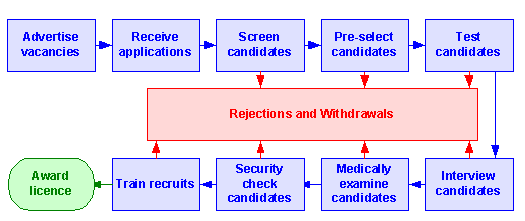|
This case study summarises an assignment which was carried out
to improve the recruitment and selection process for ab initio
air traffic controllers. A cost-benefit analysis approach was
taken.
Success Criteria
The successful recruitment and selection of the right number of
high quality ab initio air traffic controllers is essential to
ensure that flight delays caused by Air Traffic Control restrictions
are maintained at an acceptable level. Its success can be measured
by:
- the proportion of people entering training who emerge with
a licence to operate, and
- the difference between the demand and supply of newly licensed
controllers.
Problem
The cost of recruiting, selecting and training a controller is
high. A significant part of the cost arises from selecting people
who subsequently fail.
The success rate from a training course is unpredictable and will
result in a mismatch between supply and demand. A shortfall in
supply leads to insufficient airspace capacity being provided
at peak times. Airlines will suffer the cost of delays and re-routings
as a consequence.
Improvement may be desirable, but which of the many options for
changing the recruitment, and selection process should be chosen?
Three or more years may elapse between recruitment and the award
of an operating license, so any effect on the success rate in
training will not become apparent for several years. Changes cannot
be made to the any part of the process with any confidence in
a beneficial outcome.
Solution
Icon has developed an approach to estimate benefits before changes
are made to the process. This is done by identifying the variables
in the process which affect its outcome and modelling the relationship
between these variables at each stage of recruitment and selection.
In this way, the economic impact of introducing new stages and
modifying or removing existing stages can be measured. An important
part of the analysis is to examine and quantify two major errors
that occur in selection. These are:
- selecting people who will later fail (false positives), and
- rejecting people who would have succeeded (false negatives).
Benefits
Improvements to the recruitment and selection process can be identified
which will enable an organisation to reduce cost and produce more
qualified controllers.
Example: A typical multi-stage process
From every 100 applications received there may be just one person
who is awarded a licence. Of the 99 who do not qualify, there
may be 10 to 15 people who have the ability to succeed but are
rejected by a less than perfect selection process. In training,
the failure rate may be as high as 40%.
The selection process can be reconfigured to change these ratios,
but any reconfiguration will affect the cost of selection, the
cost of training, and the cost of controller shortages. An optimum
configuration of selection procedures will minimise the total
cost.

Our approach is to identify all the fixed and variable costs involved
in both filling a vacancy for a licensed controller and not filling
it, thereby creating a shortage. A model of the process is then
used to explore how the total cost can be moved towards its minimum
value.
|